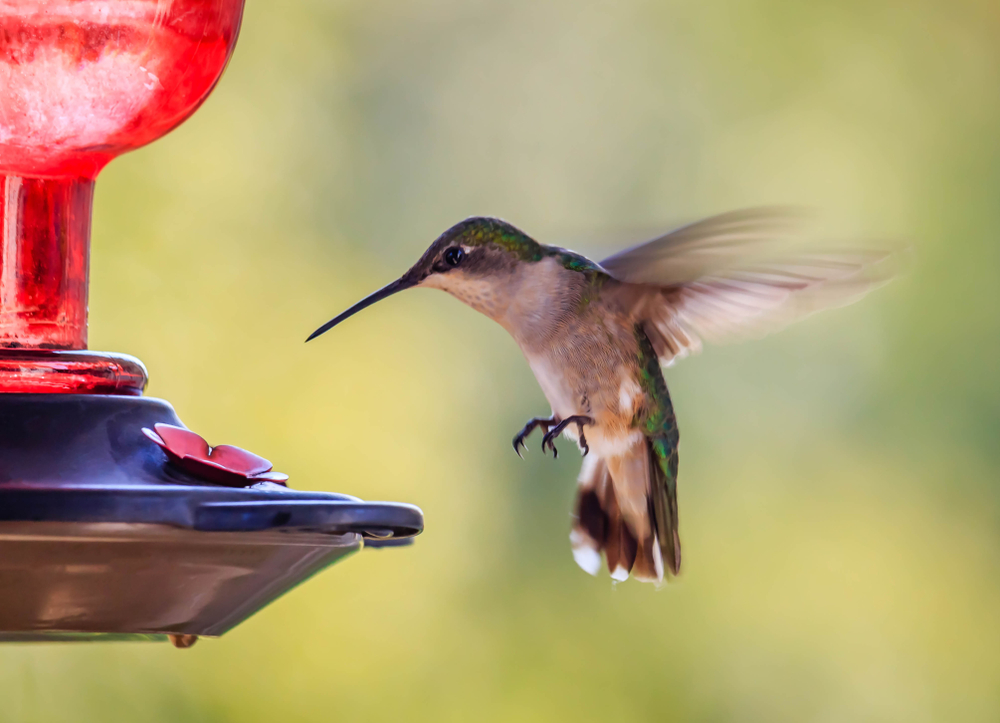Hummingbirds are "Apodiformes," a word originating from the greek "a-pod," meaning "no foot." Hummingbird feet may appear small and useless, but are essential for perching, nesting, fighting, and resting. When they fly, hummingbirds tuck their little legs and feet inwards, thus becoming more aerodynamic.
These fantastic little creatures called hummingbirds live in many parts of the world, including North America, South America, and Central America. The most common species in the states is the ruby-throated hummingbird (Archilochus colubris). These tiny birds have incredible capabilities.
Besides all the impressive features hummingbirds may have, their feet play in essential role into their fascinating nature. Hummingbirds are well known for the way they fly, and its unusual to see them just standing still – but that doesn’t mean that these little birds have no feet. Instead, they use their feet for other purposes.
Table of Contents
Hummingbird feet appearance
Hummingbird feet have four toes – three at the front and one at the back. The toe at the back is called a hallux. The hallux resembles the function of a human thumb and is used for gripping (typically onto tree branches).
Hummingbirds don’t have knee-joints. And while that sounds weird, the truth is they don’t need them. Their wings do all the work – and they never fall short. Not to mention, hummingbirds don’t have a habit of walking on the ground; they usually prefer to stick to tree branches and twigs.

Hummingbird feet uses
A hummingbird uses its’ feet for various reasons, and most importantly during the time that they are perched for rest. Hummingbirds will hang upside down (in some instances), using their feet to tightly grasp a branch while in a state of “torpor.” When in that state, hummingbirds slow down their metabolism and heart rate. So staying in one position for extended periods requires solid feet and claws.
Hummingbird feet can be used when perching (hummingbirds perch more often than you’d think) and scratching off mites (like any wild bird). They can also use the tiny feet for preening themselves. Hummingbirds use their feet to gather nesting materials for its hummingbird nest. They typically gather an assortment of moss, lichen, grass, leaves, and plant fibers held together by a spider web – the perfect glue!
Hummingbirds also use their feet when fighting – They’ll typically use their claws to attack and stretch their tail feathers to intimidate their adversaries. Since hummingbirds are territorial birds (especially Rufous hummingbirds), they can easily fight other hummingbirds for food sources and bird feeders. A low food supply is a good enough reason for them to become aggressive. Female hummingbirds also attack predators when they feel that their nest is being threatened.
Hummingbird abilities
If you weren’t sure that hummingbirds have feet and didn’t really understand how they work, you do now! But honestly, the feet may be the least impressive feature of hummingbirds. There are so many more exciting qualities that these jewels have – and they deserve our attention.
Their flight skills are nothing short of amazing! Hummingbirds can hover mid-air, fly backward and up and down, and on top of that, they never seem tired. Their wings usually flap at about 50-80 beats per second! They’re the only bird that has such an impressive skill-set. You can more accurately see their ability if you watch an online slow-motion video of them.
Hummingbirds fly around constantly, about 20% of the time during their day – while they are looking for nectar or other food sources. Hummingbirds have impressively long beaks and tongues, perfect for pollinating tubular flowers. Thus, these little fellas help the environment tremendously, pollinating tube-shaped flowers up and down the pacific coast and throughout various other states. Male hummingbirds usually sport a gorgeous colorful iridescent gorget that will impress any female hummingbird (and people alike).

Conclusion
A hummingbird can zip around and dart in and out between flowers so quickly. Plus, their tiny legs are just so cute! But don’t be fooled by their small nature: Hummingbirds are a powerhouse in the world of pollinators! And when it comes to flying, these little birds are the best.
When a hummingbird flies in front of your eyes, it’s like a sighting from another world. Their aerodynamics allow for better maneuverability. So when it comes to flying, these little birds can do things no other bird can! They can hover mid-air and fly backward—and on top of that, they can soar effortlessly through the air at up to 80 beats per second! It’s incredible how much energy these little guys have!
When it comes to the feet of a hummingbird, it’s not so much the size that matters but how you use them. Their legs are tucked under their wings when they’re flying, making it easier for them to do all those acrobatics.
Tips for Helping your local Hummingbird community
Hummingbird numbers are decreasing by the year, determining people to make conservation efforts to protect them. Climate change can change their food supply and migration patterns. But you can also help these tiny jewels by putting bird feeders up in your garden. Make sure they’re always filled with the sweet nectar (recipe: 1 part sugar to 4 parts water).
Also, don’t forget to give your hummingbird access to spots where they can perch – so your yard should have some trees they can use, or you can simply build a perch yourself. Put nectar feeders out and watch them fly like crazy little tiny helicopters. And If you want to see these hummingbirds wings in action, record them in slow-motion and watch them unfold.

